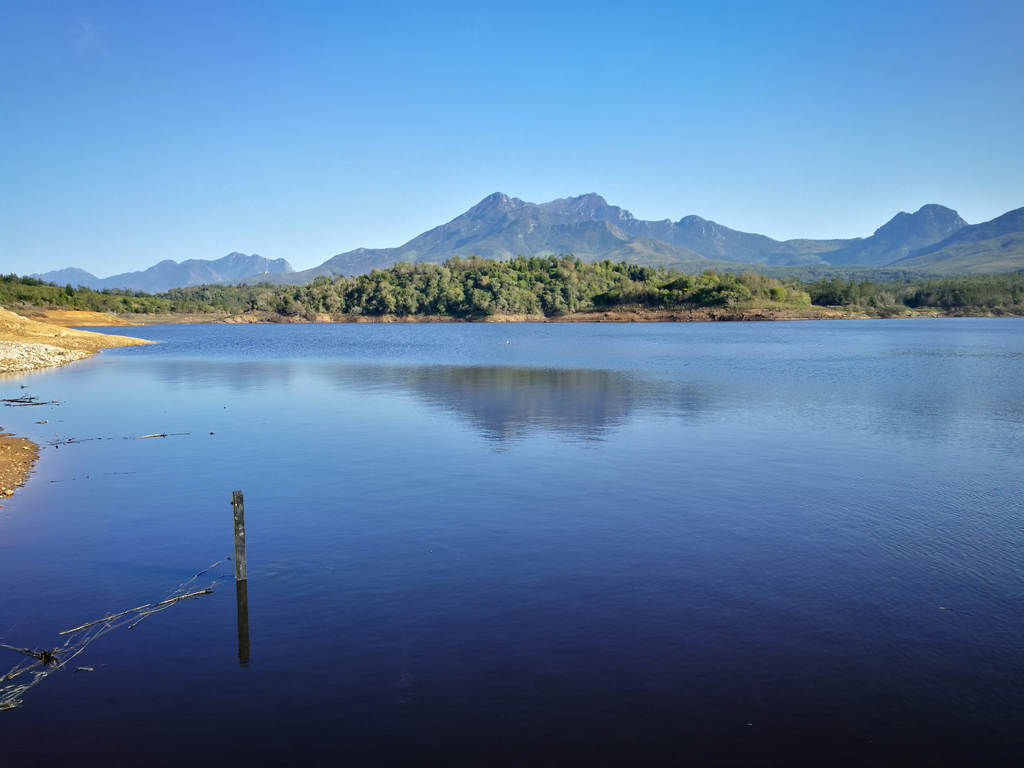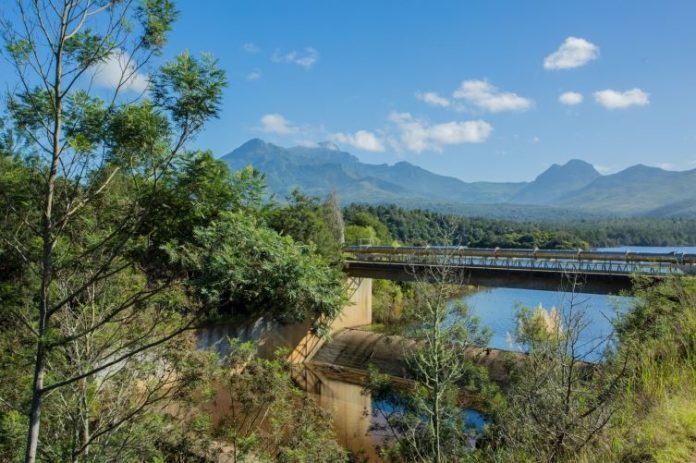Contractors for the raising of the Garden Route Dam spillway are expected to go on site next week (week of 13 May 2019) at which time the site and an extended surrounding area will be closed to the public for safety reasons.
In addition to heavy vehicles on winding plantation roads and major excavations at the dam wall and above the dam, clearing of alien vegetation right around the dam will mean the presence of dangerous equipment including woodchippers, chain saws and cutters – not to mention falling trees, snakes and other wildlife disturbed by the temporary commotion.

George Municipal Manager Trevor Botha made an urgent appeal to all hikers, cyclists, canoeists and other outdoor enthusiasts to stay clear of all plantation and forest terrain, tracks and roads south of the train tracks above the dam. “The work site is much larger than just the area directly adjacent to the dam and is potentially extremely dangerous for people who are not meant to be there. While it may be temporarily inconvenient for regular users of the terrain to find alternative outdoor space for a while, the long-term benefits of a higher dam wall and less invasive species in their natural playground will reap its own rewards.
“Please do not be tempted to ignore signage because it looks like a site is not active. There is a lot that will be happening in areas that may not be obvious and visible, and areas where work is underway may be unstable and should not be entered just because workers or equipment do not seem to be around.
“A special appeal is being made to cyclists to please find routes outside this area and to not take any chances. Heavy vehicles will be using almost all the plantation and forest roads that cyclists frequent. Cyclists speeding down mountain paths run the risk of encountering large vehicles on winding plantation roads and they may not be able to stop or get out of the way in time if they come upon a truck. The area is always considered a high-risk site 24 hours, seven days a week. Ongoing safety risk reviews will be carried out and areas will be opened to public access only if it is considered safe for general access.
“While every effort will be made to put up signage at as many points of access as possible, the area is not fenced, and the municipality will rely on citizens to help spread the word and to warn and discourage people from accessing the area. Ongoing messaging on several municipal communication channels will also take place.
“The municipality thanks residents and visitors for their support and patience during this project. It will be a temporary inconvenience but will provide longer term water security in a changing climatic environment,” said Mr Botha.

Lowering the dam level
Before the project can start, the level of the Garden Route Dam must be reduced from its current 89% to at least 80% to enable the contractors to access the currently submerged construction area. Weather-depending, the water will be released sometime in the next week via two scour valves and the water will flow out into the Kaaimans River over a period of about three to six days in dry weather conditions. The releasing of water does not hold danger for property owners and activities downstream, but the relevant parties will be informed accordingly.
“While it is not ideal to lose water at any stage, the safety of the people working below the dam is essential and for the integrity of the project as a whole, we have accepted that some water run-off is necessary. We had hoped to create a buffer or holding dam, but the scope of the project does not allow for it. However, the municipality will monitor and manage the dam level closely during the project time period and will address any supply issues in advance should it become necessary,” said Mr Botha.
Traffic implications, take care
Heavy vehicles will be delivering materials to the site, which will have an impact on Knysna Road, Madiba Drive, Mission and Industrial Roads. Heavy vehicle activity will also take place on the public roads directly adjacent to the site, including the Meyer Street entrance to the dam and Madiba Drive between Meyer Street and a plantation access road in Madiba Drive (about halfway between Meyer and Nelson Mandela University George Campus). All road users are requested to take extreme care, to not speed or overtake in blind areas.
Project details
Once completed, the dam’s full supply level will effectively be raised by 2.5 metres, which will increase the total storage capacity of the dam by approximately 25%.
The construction activity period is expected to be ten months from time of commencement. If possible, the area will be made accessible during the 2019/20 December-January holiday period, but this will depend entirely on the safety of the site and the progress of the works being constructed.
A professional dam engineer registered with the Department: Water and Sanitation (DWS) for a Category III dam will oversee the construction works. All designs for the works have been approved by the DWS’s Dam Safety Office.
Construction will occur in the dam wall and spillway area, while fill for the raising of the dam wall will be excavated on the MTO/NMU side of the dam and transported to the construction site.
About 13 000 cubic meters of excavated material will be transported for placing on the dam wall. At the same time bush clearing and alien eradication will take place within the future flood line area that extends around the dam perimeter. Earthmoving and construction plant and machinery will be stored overnight at the contractors site camp situated close to the dam wall.
Currently the spillway construction area is submerged, and the level of the dam will be artificially drawn down to allow the contractor to execute the works. The old spillway will first be removed, after which excavation to reach bedrock will commence. The future drainage channel will be excavated simultaneously. Rock anchors will be drilled into the bedrock and secured with grouting, concrete and steel reinforcement placed to provide the floor, footings and the spillway wall, a grout curtain pressure injected to prevent water ingress under the structure, and earthworks to raise the dam wall all form part of the construction activities.
Once the dam water level is low enough, the contractor can remove the existing concrete overflow crest below the existing spillway bridge. At the same time the future drainage channel will be excavated into the bedrock. This work will be in a zone that lies approximately 3.2m below the existing dam’s full supply level, due to the removal of the overflow crest and the natural fall back into the dam in the spillway channel. At the same time an approximately 700mm layer of soft rock will be removed to ensure that the proposed structure is firmly anchored into the hard bedrock layer.
Once the rough excavation work is completed, steel anchors will be drilled and grouted into the bedrock. Once successfully completed and tested, the new spillway reinforced footing will proceed.
Of note is that the driller will then return to drill holes through the footing, to inject grout under high pressure into the bedrock to ensure a watertight grout ‘curtain’ below the wall. This is to prevent water ingress into the bedrock underlying the proposed spillway structure and is a critical component. The actual spillway walls will only proceed once this grout curtain has been successfully tested for water-tightness to the required standards. This work will proceed on and off, due to the various required concrete and grouting curing periods, as well as the requirement that each aspect is carefully checked before moving onto the next phase of construction.
Project queries must be directed to: lcmooiman@george.gov.za



